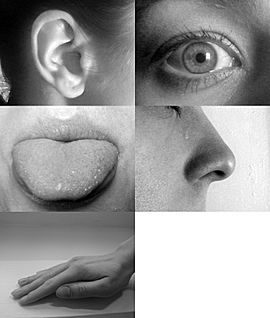Sense facts for kids


A sense is a physiological capacity of organisms that provides data for perception. The senses and their operation, classification, and theory are overlapping topics studied by a variety of fields, most notably neuroscience, cognitive psychology (or cognitive science), and philosophy of perception. The nervous system has a specific sensory nervous system, and a sense organ, or sensor, dedicated to each sense.
Humans have a multitude of sensors. Sight (vision, visual sense), hearing (audition, auditory sense), taste (gustation, gustatory sense), smell (olfaction, olfactory sense), and touch (somatosensation, somatosensory sense) are the five traditionally recognized senses. The ability to detect other stimuli beyond those governed by these most broadly recognized senses also exists, and these sensory modalities include temperature (thermoception), kinesthetic sense (proprioception), pain (nociception), balance (equilibrioception), vibration (mechanoreception), and various internal stimuli (e.g. the different chemoreceptors for detecting salt and carbon dioxide concentrations in the blood, or sense of hunger and sense of thirst). However, what constitutes a sense is a matter of some debate, leading to difficulties in defining what exactly a distinct sense is, and where the borders lie between responses to related stimuli.
Other animals also have receptors to sense the world around them, with degrees of capability varying greatly between species. Humans have a comparatively weak sense of smell and a stronger sense of sight relative to many other mammals while some animals may lack one or more of the traditional five senses. Some animals may also intake and interpret sensory stimuli in very different ways. Some species of animals are able to sense the world in a way that humans cannot, with some species able to sense electrical and magnetic fields, and detect water pressure and currents.
Definition

A broadly acceptable definition of a sense would be "A system that consists of a group of sensory cell types that responds to a specific physical phenomenon, and that corresponds to a particular group of regions within the brain where the signals are received and interpreted." There is no firm agreement as to the number of senses because of differing definitions of what constitutes a sense.
The senses are frequently divided into exteroceptive and interoceptive:
- Exteroceptive senses are senses that perceive the body's own position, motion, and state, known as proprioceptive senses. External senses include the traditional five: sight, hearing, touch, smell and taste, as well as thermoception (temperature differences) and possibly an additional weak magnetoception (direction). Proprioceptive senses include nociception (pain); equilibrioception (balance); proprioception (a sense of the position and movement of the parts of one's own body).
- Interoceptive senses are senses that perceive sensations in internal organs.
Non-human animals may possess senses that are absent in humans, such as electroreception and detection of polarized light.
In Buddhist philosophy, Ayatana or "sense-base" includes the mind as a sense organ, in addition to the traditional five. This addition to the commonly acknowledged senses may arise from the psychological orientation involved in Buddhist thought and practice. The mind considered by itself is seen as the principal gateway to a different spectrum of phenomena that differ from the physical sense data. This way of viewing the human sense system indicates the importance of internal sources of sensation and perception that complements our experience of the external world.
The sensory system of animals
The human sensory system is usually said to have six senses:
- Hearing is the sense of sound that comes into our ears.
- Sight is the sense of seeing things with our eyes.
- Touch is the sense of feeling things with our skin.
- Taste is the sense of the flavor of things with our tongues
- Smell is the sense of smelling things with our noses.
- Kinesthetic sense is knowing where your whole body is and where it is not.
Other animals may have other senses. Fish have lateral lines which detect changes in the water pressure around them, and some can detect changes in electric fields around them.
Images for kids
-
The sense of smell Bequest of Mrs E.G. Elgar, 1945 Museum of New Zealand Te Papa Tongarewa.
See also
 In Spanish: Sentido (percepción) para niños
In Spanish: Sentido (percepción) para niños




